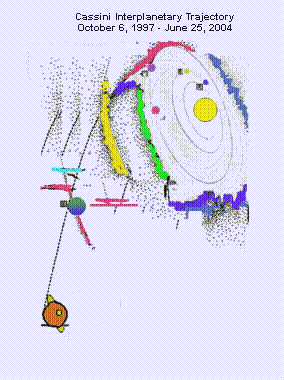Interplanetary Trajectory
October 15, 1997-June 25, 2004


Cassini's Tentative Schedule:
Cassini Launch: Oct. 6, 1997 (Rescheduled to 10/15/97)
Venus Flyby: April 21, 1998 ?
Venus Flyby: June 20, 1999 ?
Earth Flyby: August 16, 1999 ?
Jupiter 6: Dec. 30, 2000 ?
Saturn: June 25, 2004 ?
Launch Risk: The odds of a failure during the launch on a Titan IV rocket are, "between one in ten and one in twenty," according to John Pike, head of the Federation of American Scientists. (5)
"Flyby" risk: During the "flyby" scheme - when Cassini shoots back toward Earth from Venus, in order to use Earth's gravity and increase its velocity for the trip to Saturn, Cassini will be traveling 42, 300 mph and trying to circle the globe only 312 miles overhead. But if Cassini falls into Earth's 75-mile deep atmosphere, the machine will disintegrate, globally dispersing minute particles of plutonium oxide.
The amount of plutonium that NASA calculated might be released under those circumstances is "an astronomical quantity of a potent alpha-emitting cancer producer," writes Dr. John Gofman, medical physicist and co-discoverer of uranium-233. "The number of cancer doses is so high as to make calculations extraneous." (6) NASA claims that Cassini's plutonium power pack is built into a tough container that will withstand any accidental crash through the Earth's atmosphere.
Karl Grossman, a professor of journalism who has written extensively on the dangers of nuclear power in space, talked with Dr. Horst Poehler, a veteran of 22 years of work with NASA contractors at the Cape. Dr, Poehler said that the shielding for the plutonium on Cassini is, "fingernail thin. Itís a joke." (7)
"They have no right to do this in a populated area," Poehler said. Poehler suggests that NASA should launch with another agency that has a more isolated and less-populated launch site. (8)
What You Can Do:
Contact the Florida Coalition for more information or to purchase a copy of the award-winning "Nukes in Space" videotape: Florida Coalition for Peace and Justice, P.O. Box 90035, Gainesville FL 32607, (352) 468-3295
Participate in the Coalition's campaign of education and action to stop future launches..
Organize a letter-writing campaign to your congressional delegation.
2) Congressional hearings to investigate: a) the potential consequences of a "Plutonium Challenger" disaster over Florida; and b) alternatives to the plutonium powered deep space missions.
3) Urge your local cable provider and public broadcasting stations to show the "Nukes in Space" video.
4) Use the information available from the FL Coalition to write letters to newspaper editors.
Send copies of your letters to news directors at your local TV and radio stations and insist they report on the issue.
NOTES:
1) "Stop using Plutonium in Space," Global Response, G.R. No. 3, 1997, Boulder, CO. (303) 444-0306, website:www.globalresponse.org;
2) Final Environmental Impact statement for the Cassini Mission, NASA, June, 1995, p. 4-76;
3) David Chandler, "Hot Spot": Mars 96 failure renews concern about plutonium carrying spacecraft," The Boston Globe , Dec. 9, 1996;
4) Ibid., n. 3;
5) Ibid., n. 1;
6) Ibid., n. 1;
7) Dr. Karl Grossman, "Nuclear menace in Outer Space," commentary, The Baltimore Sun, Dec. 8, 1996;
8) Marilyn Meyer, Risks of plutonium launch debate," Florida Today, May 21, 1995;
9) Ibid., n. 8;
10) European Space Agency, "New Solar Cells with record efficeincy," Press Information Note, No. 07-94, Noordwijk, Netherlands, April 29, 1004;
11) Just Peace, newspaper of the Florida Coalition for Peace and Justice, Vol. 15, No.1, p.6;
12) Press release, June 25, 1997, Florida Coalition for Peace And Justice;
13) Geov Parrish, "How NASA could doom life on Earth this October, Eat the State!, Seattle WA, June 17, 1997;
14) "Self-destructive Rocket," The New York Times, January 18, 1997, p. A7;
15) Ibid., n. 3
16) "Lab contamination rises: Alamos cites NASA project," (AP), The Denver Post, July 30, 1996.
See also: Dr. Karl Grossman, "Risking the World: Nuclear Proliferation in Space," Covert Action Quarterly, Summer, 1996.
This article, which was edited slightly by Proposition One Committee after the Cassini launch, was prepared before the launch by
The Progressive Foundation
P.O. Box 649
Luck, WI 54853-0649
(715) 472-4185
nukewtch@win.bright.net
(Produced and printed with a grant from the Northern Futures Foundation, Rt. 1 Box 71, Port Wing, WI 54865, (715) 774-3374.)